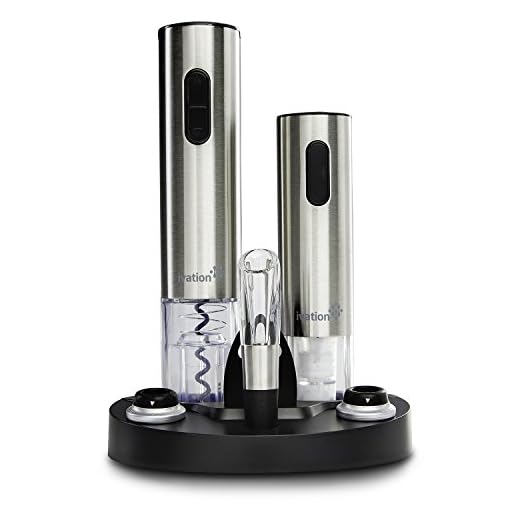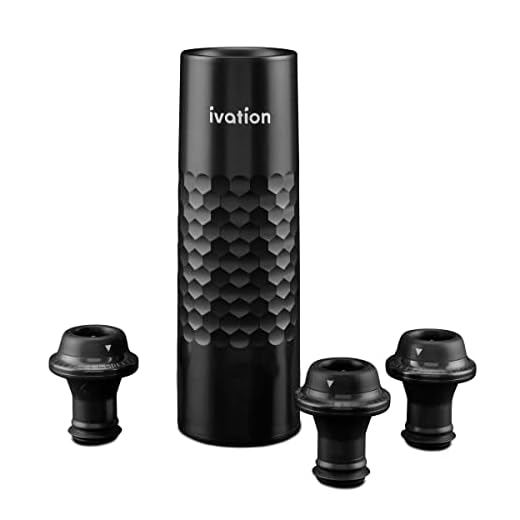



Once a bottle is uncorked, it typically remains enjoyable for about three to five days. This timeframe can vary based on several factors, including the type of closure and the storage conditions.
Utilizing a cork or a specialized stopper can help maintain freshness, while refrigeration slows down the oxidation process. If kept in a cool, dark place and sealed tightly, you can extend the lifespan of the beverage slightly.
After this period, you may notice changes in flavor and aroma, as exposure to air gradually alters the characteristics. It’s best to trust your senses; if it smells sour or tastes off, it’s time to discard it. Always aim for enjoying your opened bottles within the recommended timeframe to fully appreciate their quality.
Recommended Duration for Enjoying Opened Bottles
Once a bottle is uncorked, you typically have about three to five days to savor its flavors. The key factor influencing this timeframe is exposure to oxygen, which can alter the profile of the beverage. If stored properly, you may extend the enjoyment period slightly.
Storage Tips for Optimal Freshness
To maximize the lifespan of an opened bottle, reseal it with its original cork or a wine stopper. Keeping it upright reduces contact with air, minimizing oxidation. Store in a cool, dark place, ideally at temperatures between 50°F and 65°F. Avoid exposure to direct sunlight or heat sources, as these can accelerate spoilage.
Signs of Deterioration
Pay attention to changes in aroma and taste. If you notice a sharp, vinegar-like scent or a flat, unbalanced flavor, it’s time to discard the contents. Enjoying the nuances of a freshly opened bottle is part of the experience; trust your senses to guide you.
Factors Affecting Shelf Life of Opened Red Wine
Temperature plays a significant role in determining how quickly a bottle deteriorates. Ideally, storage should be at a consistent, cool temperature between 55°F and 65°F. Higher temperatures accelerate oxidation and spoilage.
Exposure to air is another crucial element. Once a bottle is uncorked, oxygen begins to interact with the liquid, leading to oxidation. The longer the exposure, the more pronounced the changes in flavor and aroma. Using a vacuum pump can help reduce air contact and extend freshness.
Light can also degrade the quality of an opened bottle. Ultraviolet rays break down compounds in the liquid, leading to undesirable flavors. Store bottles in a dark place or use tinted bottles to mitigate this effect.
Closure Type
- Natural corks allow some air exchange, which can be beneficial for aging but detrimental for short-term storage.
- Screw caps provide a tighter seal, limiting oxygen exposure, thus retaining freshness longer.
Wine Quality and Composition
The initial quality of the liquid influences its longevity once opened. Full-bodied varieties with higher tannin content typically last longer than lighter options. Additionally, the presence of sulfites helps slow oxidation.
In summary, monitor temperature, limit oxygen exposure, shield from light, consider the type of closure, and remember the starting quality of the beverage to determine its longevity post-uncorking.
Signs That Your Red Wine Has Gone Bad
Oxidation is a primary indicator that a bottle has spoiled. If you notice a brownish hue instead of the usual vibrant color, it’s a clear sign of deterioration. Additionally, if the aroma shifts to a vinegary scent or exhibits musty notes, discard the bottle immediately.
Another telltale symptom is the presence of bubbles or fizz in a bottle that should be still. This can indicate unwanted fermentation. Taste is also a crucial factor; if the flavor is overly sour or has a flat profile, it’s best to avoid consuming it.
Storage conditions play a significant role in the longevity of an opened bottle. If you stored it in a warm area or exposed it to light, check for signs of spoilage more rigorously.
| Signs of Spoilage | Description |
|---|---|
| Color Change | Brownish tint instead of vibrant hues |
| Off-Aroma | Vinegary or musty scents |
| Bubbles | Presence of fizz in still varieties |
| Taste | Sour or flat flavor profile |
| Storage Conditions | Exposure to warmth or light |
Keeping these indicators in mind will help ensure you enjoy only the finest selections. Trust your senses; if something seems off, it’s better to err on the side of caution.
Best Storage Practices for Opened Red Wine
To preserve the quality of your opened bottle, store it upright in a cool, dark place. Light and heat accelerate degradation, so aim for a temperature between 50°F and 65°F (10°C – 18°C).
Utilize a wine stopper to minimize air exposure. A vacuum pump can also be effective in removing excess oxygen, further extending its lifespan. Ensure the seal is tight to prevent oxidation.
Refrigeration is beneficial; even red varieties can be stored in the fridge. Just allow the bottle to reach room temperature before serving. This method slows down the aging process significantly.
Avoid frequent temperature fluctuations. Once you’ve found your optimal storage location, maintain a consistent environment to prevent compromising flavors.
Finally, consume the remaining liquid within a week for the best experience. Each day that passes after uncorking alters its profile, so savor it while it’s still at its peak.
Optimal Temperature for Keeping Wine Fresh
The ideal range for preserving opened bottles sits around 55°F to 65°F (13°C to 18°C). Maintaining this temperature helps to slow oxidation and keeps flavors intact. Aim for a consistent environment, avoiding fluctuations that can compromise quality.
Storing bottles in a wine fridge specifically designed for this purpose is an excellent choice. If a wine fridge isn’t available, placing a bottle in a cool, dark cupboard away from heat sources works well. Exposure to light and heat can lead to undesirable changes in taste and aroma.
When serving, allow the beverage to warm slightly from cellar temperature to enhance aromas. Pouring a glass and letting it breathe at room temperature for about 15-30 minutes can elevate the tasting experience. However, be cautious not to exceed the upper temperature limit, as this can lead to spoilage.
If you have a partial bottle, reseal it tightly with the original cork or a specialized stopper. This minimizes air contact, preserving the essence for a longer duration. Remember, the right temperature is crucial for an enjoyable tasting session.
Utilizing Wine Preservation Tools
Investing in preservation tools significantly enhances the longevity of your opened bottles. A vacuum pump is one of the best options. By removing air from the bottle, it slows oxidation, which is crucial for maintaining flavor and aroma. Aim to pump until you feel resistance, indicating a proper seal.
Another effective device is the wine preservation spray. These sprays release a protective layer of inert gas that sits atop the liquid, preventing contact with oxygen. A few quick bursts are all you need for optimal protection.
Consider a wine preservation system that utilizes a specialized stopper. These stoppers often have a built-in vacuum mechanism and can extend freshness for several days or even weeks, depending on the quality of the seal.
Temperature control is also essential. A wine fridge or a dedicated cooler allows you to maintain an ideal environment for your bottles. Keeping the temperature stable reduces fluctuations that could compromise your drink.
Lastly, always store the bottle upright. This minimizes the surface area exposed to air and helps maintain the integrity of the cork, preventing it from drying out and letting in unwanted oxygen.
Comparing Different Types of Red Wine Longevity
Cabernet Sauvignon typically lasts 3 to 5 days post uncorking. Its robust structure allows it to resist oxidation better than many other varietals.
Merlot, with its softer tannins, is best consumed within 2 to 4 days once opened. The fruit-forward profile can diminish quickly, leading to a less enjoyable experience.
Pinot Noir often requires consumption within 2 to 3 days due to its delicate nature. Exposure to air can quickly alter its subtle flavors, making timely enjoyment essential.
Zinfandel can hold up for about 3 to 5 days, particularly if stored properly. Its higher alcohol content and fruitiness help maintain its character longer.
Syrah/Shiraz offers a lifespan of around 3 to 5 days as well, benefiting from its bold taste and tannin structure, which can help it withstand oxidation.
For a comparative overview:
- Cabernet Sauvignon: 3-5 days
- Merlot: 2-4 days
- Pinot Noir: 2-3 days
- Zinfandel: 3-5 days
- Syrah/Shiraz: 3-5 days
Every varietal’s longevity is influenced by its structure, acidity, and the winemaking process. Choosing a bottle that suits your immediate consumption plans can enhance your tasting experience. Always consider the specific characteristics of the type you select to maximize enjoyment.
When to Consider Discarding Opened Wine
Dispose of the bottle if it has been open for more than five days. Typically, a few days after uncorking, the quality begins to deteriorate significantly. If you notice any off-putting odors or flavors, it’s a clear sign that it’s time to let it go.
Storage Duration and Quality
After three days, the taste can start to shift; five days is generally the maximum. Beyond this period, not only does the flavor decline, but the risk of harmful bacteria increases. Always trust your senses: a sour, vinegar-like scent or an unpleasant taste indicates spoilage.
Environmental Factors
Consider the storage conditions. If the bottle has been exposed to heat or direct sunlight, it may spoil faster. Using a vacuum pump can extend the lifespan, but it’s still essential to keep it in a cool, dark place. If you’re considering a backup power solution for refrigeration, check out the best solar generator to run refrigerator to maintain optimal storage conditions.







